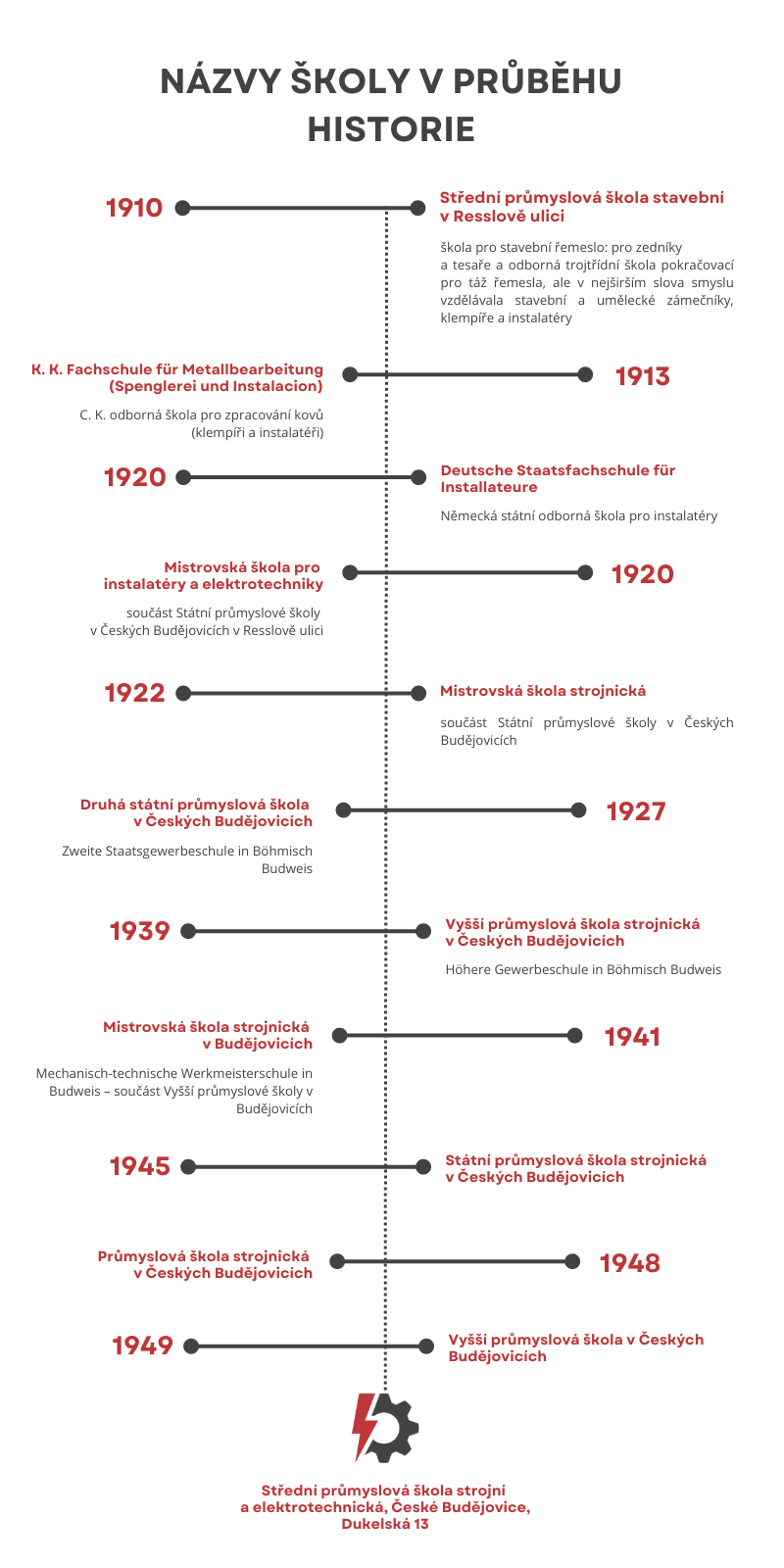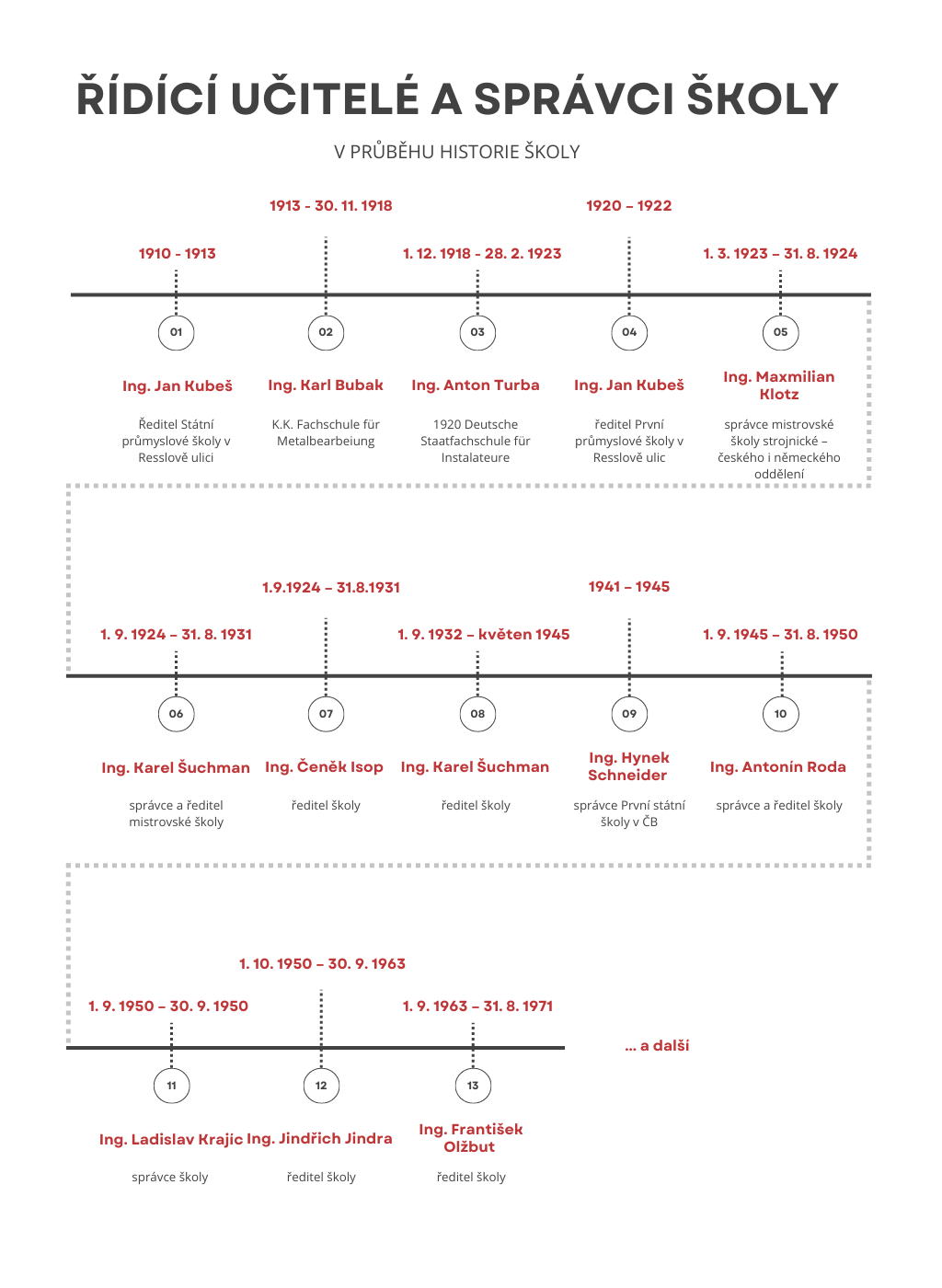Beginnings and origins of our school "Dukla"
Written according to Chronicle 1: Chronicle from 1975 - correspondence based on scarce archival material, memories and memoirs (were, heard).
In České Budějovice there was a Czech gymnasium since 1868, but there was a noticeable lack of a Czech vocational school. The town leadership refused to establish one, arguing that the Czech population was small and the school would not have enough pupils.
On 2 May 1899, the "Report of the Trade Commission" was issued on the contents of 131 petitions of South Bohemian municipalities and communities requesting the establishment of a Czech state industrial school in Č. Budějovice. The report was sent to the session of the Assembly of the Kingdom of Bohemia. The report contained information on the population of Č. Budějovice: in 1890 28,491 inhabitants / of which 16,585 were Czechs, in 1899 there were already 32,000 inhabitants / of which 2/3 were Czechs. The mostly Czech population is therefore entitled to have their children educated in their mother tongue.
The Chamber of Commerce and Trades also conducted a census of trades in each judicial district, where Czech trades and districts also predominated. From all the facts ascertained, it was then shown that Č. Budějovice needed to establish a Czech state industrial school and had the right to do so. In addition, the Chamber of Commerce and Trade declares that it is ready to finance the construction costs from its own funds. "Vienna" initially rejected the original request, but in the end there was no avoidance and the building was granted permission. Secondary Industrial School of Construction in Resslova Street, the building was brand new, the street was then called Beerova. The first director was appointed Ing. Jan Kubeš.
The school had this organization:
- school for building trades (for masons and carpenters),
- a vocational three-class continuation school for the same trades, but in the broadest sense of the word.
The first type of school was conducted in three winter courses of five months each. The second type of school trained building and artistic locksmiths, plumbers and plumbing technicians.
It is important that the school was founded by the Chamber of Commerce and Industry, not the municipality. The opening of the Czech Industrial School in České Budějovice prompted the German leadership of the town hall to decide to establish a school of a similar type, but with German teaching. The town built a new building in which teaching began in 1913. The building had 6 classrooms, 8 workshops and 10 auxiliary rooms. The whole area had central heating, which was provided by the janitor from the boiler room. Its establishment was justified by the needs of the local metalworking industry and tradesmen, and at the same time it was seen as compensation for the Czech school (as was often the case at that time due to political circumstances). So it came to pass that a new school building was erected on the site where the Mill Drain originally flowed, there were swamps and alder wicker grew. Because of the minority German population, the school had to look for its pupils in the entire South Bohemian region and in the Upper Austria region.
The school had an official name K. K. Fachschule für Metallbearbeitung (Spenglerei und Instalacion) /= C. K. Vocational School for Metalworking (plumbers and fitters)/. The opening ceremony was attended by the mayor Josef Taschek (German Social Democrat) and Dr. Augustin Zátka (Czech representative). The commemorative plaque from this act is lost. The first director was Ing. Karl Bubak and the school had 6-8 in-house teachers.
The German vocational school was more oriented towards the black trades (engineering). This German school was the predecessor of our present school. It was a seven-month school, with classes on Sundays from 8 am to 12 noon and on weekdays from 1:30 pm to 7 pm. Attendance was compulsory for all apprentices who lived or studied within a three-mile radius of the school's headquarters.
The school was organized as a three-year vocational metalworking school for the purpose of vocational education of pupils (after completing compulsory schooling) in the trades of plumbing and plumbing. Since 1916, graduates could continue in the fourth year of the electrical installation trade. The number of pupils in a class was then 20-25.
During World War I, many teachers and pupils went to the front, so teaching was significantly reduced. After the First World War came a series of changes associated with the establishment of the new Czechoslovak Republic. The headmaster left Ing. Bubak and a member of the teaching staff took his place Ing. Anton Turba. In 1920 the school was renamed Deutsche Staatsfachschule für Installateure /=German State Vocational School for Plumbers/- was two years old. After World War I, Czech education was a priority, the German school was limited by the region of South Bohemia (no pupils from Austria), the German industrial school was in decline (only 7 or 3 pupils in a class), therefore in the school year 1920/1921 it was decided that a Czech department would be attached to the German master plumbing school, with the school being managed by the headmaster State Industrial School in Resslova Street, Ing. Jan Kubes.

